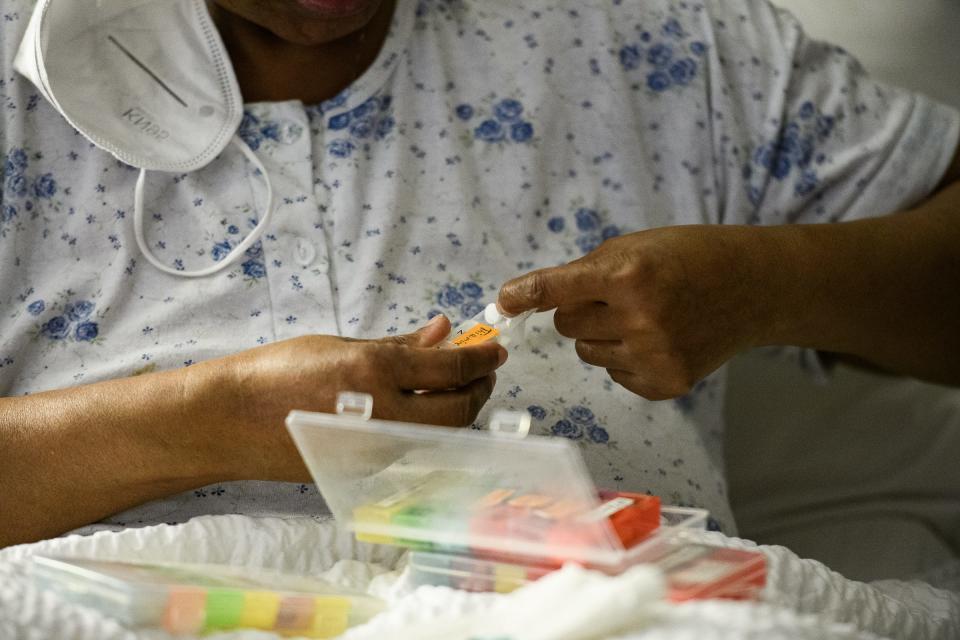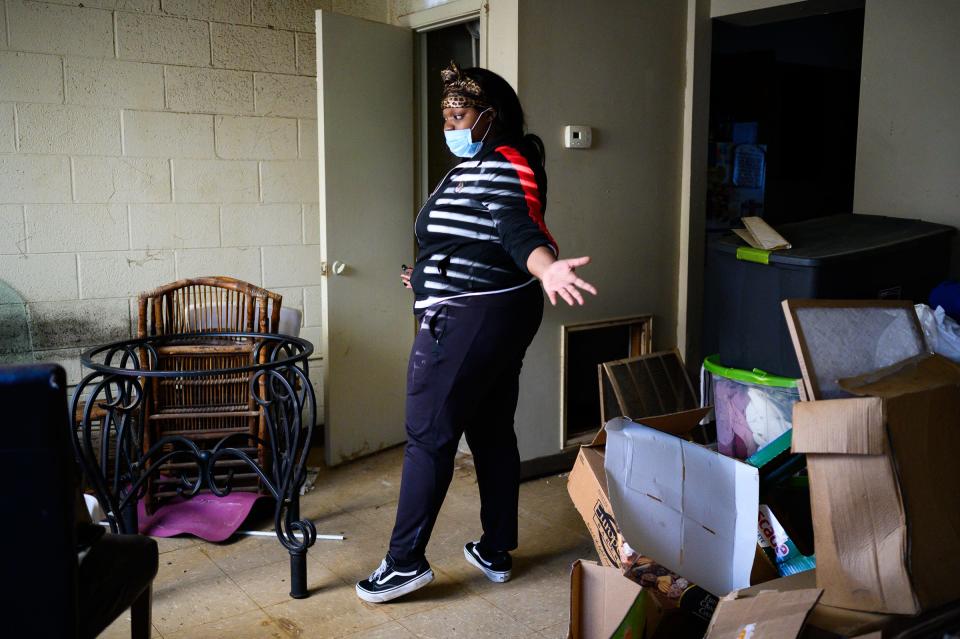Flaws in the Section 8 program leave poor people trapped in ‘monstrous, depressing places’
Note: This story is part of a six-month investigation by USA TODAY-Southeast called "Segregated by Section 8," which followed public housing seekers and analyzed available data in new ways. Read more about the series here.
CHARLESTON, S.C. – Near the litter-strewn grounds of the Wragg Borough Homes, tourists come to see the elegant houses and traditional Southern architecture that have come to symbolize this waterfront city.
But inside the public housing complex that bears the name of a slave trader, Theresa Mozzee and her daughter, Miracle, saw another side of history.
Month after month, they complained to the Housing Authority of the City of Charleston in South Carolina, the local agency that oversees public housing for the poor, about the roaches that crawled in and out of their microwave, the mildew and suspected mold that covered the cabinets and a rat who chewed a hole in the wall.
“The apartment is falling apart, it smells moldy, you smell wet wood and sewage,” noted a complaint letter dated June 14, 2020, that Theresa Mozzee wrote to the agency. “I started having bad headaches, coughing like I’m choking, throwing up, etc. ... Please send maintenance because we can’t keep living like this. I don’t want to end up in the hospital because of these issues.”
Six months later, a doctor said a respiratory illness she suffered might be caused by exposure to mold.
Segregated by Section 8: A federal program tries to house people. But it leaves many homeless and segregated in the Southeast.

People like Theresa and Miracle Mozzee, who are Black, are facing the consequences of history.
As part of the New Deal, the federal government attempted to revive the housing industry by financing the construction of hundreds of thousands of public housing units across the country starting in the late 1930s. Some researchers and historians say the program helped codify racial apartheid into official federal housing policy.
Most of the homes were built for whites and were seen as modern and desirable.
Black people were almost always excluded from buildings that housed white people. But as more whites moved out of public housing and more Black people in, the federal government let thousands of apartments fall into disrepair.
Now, Black people make up about 13% of the U.S. population but more than 40% of the tenants who live in the nation’s roughly 1 million public housing units. In large urban centers, they often make up the overwhelming majority of public housing tenants.
More in this series: Section 8 housing program reinforces a Jim Crow pattern in the South, data shows

Most tenants make less than $20,000 a year, leaving them without money to buy a house or pay for an apartment on the private market.
They live in buildings and complexes where there is a $70 billion backlog of repairs, according to a 2019 report from the National Low Income Housing Coalition, a leading Washington-based advocacy group. More than 10,000 public housing units are shuttered each year because they are considered uninhabitable, the report noted.
The federal government reduced its investment in public housing nearly 50 years ago, promising senior citizens, the disabled and other vulnerable people they could get Section 8 vouchers – a highly sought-after subsidy that allows poor people to pay a portion of their income for a privately owned house or apartment. The federal government pays the remainder.
But across North Carolina, South Carolina, Georgia and Virginia, four states where federal policy reinforced Jim Crow-era laws, people wait as long as 10 years to get Section 8. Most people who qualify for vouchers don’t get any help.
Theresa and Miracle Mozzee lived in Wragg Borough Homes for five years, unable to pay for housing on their own or obtain a Section 8 voucher.
Theresa Mozzee, 59, suffers from cancer and lupus and struggles to walk. Her 23-year-old daughter quit her job as a preschool teacher to care for her mom.
Their only income was about $1,400 per month in federal disability benefits, less than the cost of a typical two-bedroom apartment in Charleston.
For months, they had tried to put their names on a waiting list for housing choice vouchers, but the list is closed because it already contains hundreds of names. It remains uncertain when the list will open again.
Theresa Mozzee, who has been diagnosed with depression, said the situation took a mental toll.
“I have bad days,” she said. “Sometimes, I just want to die.”
Broken homes
Section 8 is a $22 billion-a-year program overseen by the federal Department of Housing and Urban Development but administered by local public housing agencies.
Recipients typically put 30% of their monthly income toward rent, while the government program covers the balance of rent and utilities. More than 2 million households nationwide rely on the program.
A USA TODAY Network-Southeast investigation found that flaws in the federal government’s biggest rental assistance program have left vulnerable people in the South living in substandard housing, in pay-by-the-week motels or doubled up with relatives.

The federal government failures have reinforced the lingering effects of Jim Crow across the South and contributed to racial disparities seen in nearly every facet of American life.
After War World II, the Federal Housing Administration provided money for construction of new suburban neighborhoods. White families who once lived in public housing could obtain low-cost mortgages for almost the same costs they paid for public housing.
The government refused to give mortgages to Black people and required that developers draw up covenants barring Black people from the neighborhoods.
In the early 1970s, as Black people occupied more and more public housing units, President Richard Nixon put a moratorium on construction of new government housing. Nixon and other leaders promised tenants they could leave public housing by using vouchers to rent decent housing from the private market.

Nixon described public housing as “monstrous, depressing places – rundown, overcrowded, crime-ridden.”
But the federal government has largely broken its promise to give voucher holders the chance to move to neighborhoods with strong schools, jobs and predominately white areas where minorities historically have been denied access.
At the same time, the public housing suffered. As people with higher incomes left the buildings – and the ability to pay higher rents – there was less money to pay for fixing things up. Backlogs of repairs mounted.
President Joe Biden’s $2 trillion infrastructure proposal includes $40 billion for repairs and improvements to public housing. The White House says the plan would disproportionately benefit people of color, women and people with disabilities.
Some Democrats have attacked the plan, saying it is insufficient to address problems across the nation. Dozens of Democrats signed a letter urging Biden to guarantee vouchers for all eligible citizens and set aside a minimum of $70 billion for repairs to public housing.
Sen. Pat Toomey, the highest-ranking Republican on the Banking, Housing and Urban Affairs Committee, said spending taxpayers’ money on public housing and other programs is a mistake.
“Amazingly, the administration wants Congress to spend $40 billion to restore public housing projects – places where people don’t want to live,” Toomey said in a written statement.
‘I have broken down’
A few blocks away from Wragg Borough Homes, houses sell for as much as $1 million. The Mazyck-Wraggborough neighborhood is more than 70% white.
But nearly all of Theresa Mozzee's neighbors in the 128 units at Wragg Borough Homes were Black and poor. The complex was built in the 1940s as segregated public housing for Black people. Charleston’s hot and humid weather and rains make the buildings susceptible to mold and flooding.
A lifelong Charleston resident, Theresa Mozzee brought her family to the complex when her health started to fail, and she didn’t have the money to move anywhere else.

Theresa once spent 16 hours each day running a small business cleaning buildings. She owned a five-bedroom house where she and her husband started a family with three children.
Sometime in 2008, her health started to deteriorate. She endured nine surgeries, including a procedure in which doctors removed most of her stomach. For three years, she ate only baby food and drank liquids because that was all her body could digest.
She takes dozens of medications each day and uses a cane to walk. Her demeanor is warm and sweet, but she becomes winded while speaking.
Some days, she can’t get out of bed.
Miracle Mozzee said she regularly checks online to see when the waiting list for vouchers will open. Each time, she said, the list has been closed.
“We have had so many episodes where she has broken down and I have broken down,” Miracle Mozzee said. “Stress makes my mom sicker. I honestly don’t know what we are going to do. Our backs are against the wall.”
Fred Clasen-Kelly is an award-winning enterprise and investigative reporter based in Charlotte, North Carolina. He is the Housing & Social Justice Ramifications reporter for USA TODAY Network-Southeast. Send story tips to fclasenkelly@gannett.com.
The team behind Segregated by Section 8
Reporting: Fred Clasen-Kelly
Visual journalism: Josh Morgan, Ariana Torrey, Mike Hensdill, Richard Burkhart
Editor: William Ramsey
Maps & Data: UNC-Charlotte’s Urban Institute with Providence Adu and Katie Zager, USA TODAY Network’s Chris Amico
Digital production & development: Ryan Hildebrandt, Spencer Holladay
Fact-checking: Rachel Berry
Proofing: Donnie Fetter, Amy Dunn
Social media, engagement & promotion: Kara Edgerson, Zach Dennis and Lauren Young
This article originally appeared on USA TODAY NETWORK: Section 8 flaws leave people in poor conditions, crime-ridden areas

 Yahoo Movies
Yahoo Movies 
